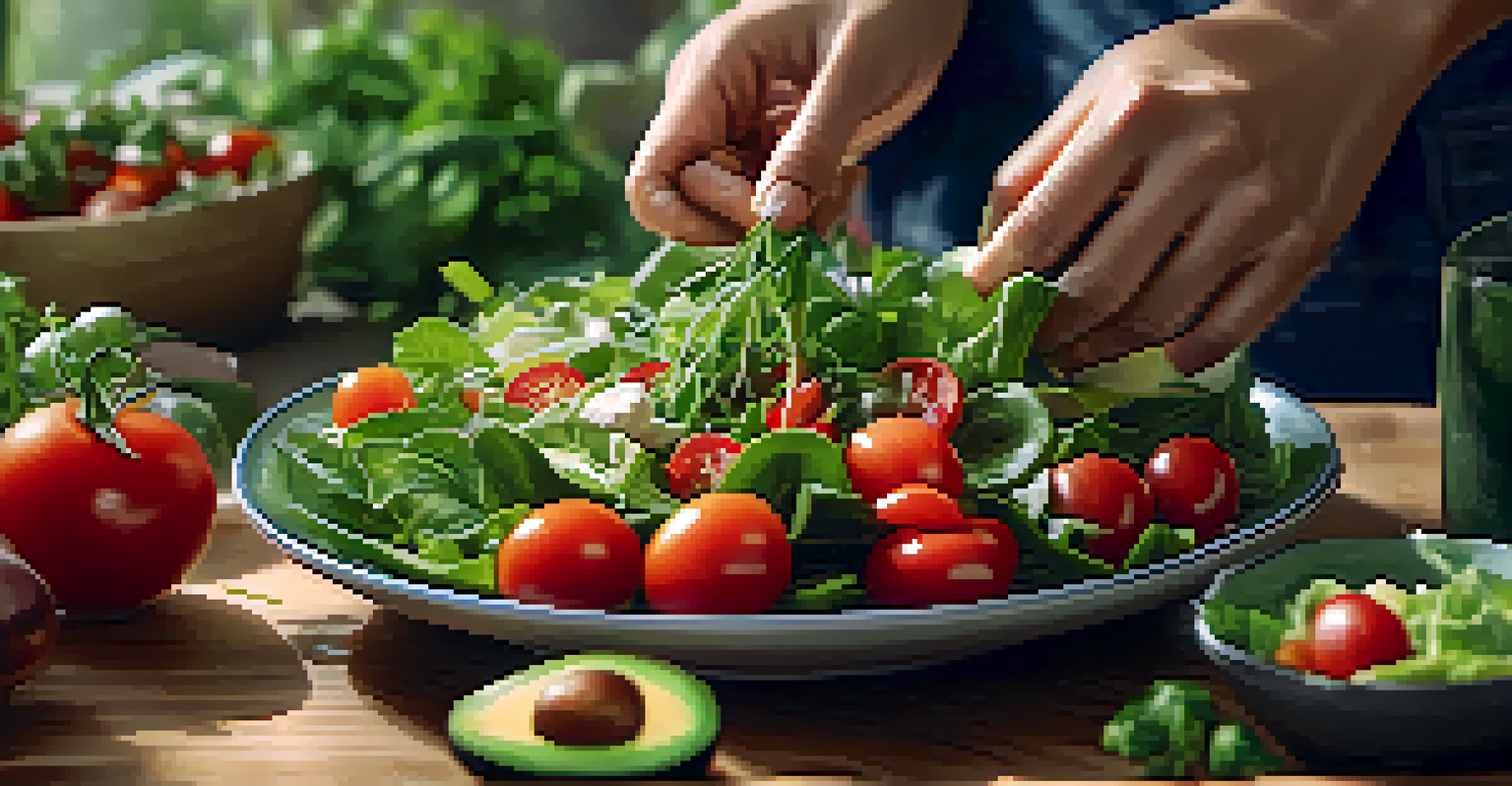Mindful Vegan Eating: How to Savor Stress-Relieving Meals

Understanding Mindful Eating and Its Benefits
Mindful eating is all about being present and aware of your food. It encourages you to savor each bite rather than rushing through meals. This practice not only enhances your eating experience but also promotes better digestion and satisfaction.
Mindful eating is about being present and aware of what you're eating, allowing us to savor our food and enjoy every bite.
When you eat mindfully, you become more attuned to your body’s hunger and fullness cues. This awareness helps prevent overeating, making it easier to maintain a healthy lifestyle. Plus, it can transform meals into moments of joy rather than just a means to fuel your body.
Incorporating mindfulness into vegan eating allows you to appreciate the vibrant colors, textures, and flavors of plant-based foods. This heightened awareness can reduce stress, turning mealtime into a peaceful ritual instead of a hurried task.
Choosing Stress-Relieving Vegan Ingredients
Certain vegan foods are known for their stress-relieving properties. For instance, foods rich in omega-3 fatty acids, like walnuts and flaxseeds, can help reduce anxiety. Incorporating these ingredients into your meals can support both mental health and physical well-being.

Leafy greens, such as spinach and kale, are packed with magnesium, which is essential for regulating cortisol, the stress hormone. By including these greens in your diet, you can foster a calming effect on your body and mind.
Mindful Eating Enhances Enjoyment
Practicing mindful eating allows you to savor each bite, improving your overall dining experience and digestion.
Don’t overlook the power of whole grains either! Quinoa and brown rice provide complex carbohydrates that boost serotonin levels, enhancing your mood and reducing stress. Choosing these foods consciously can create a grounding foundation for your meals.
Creating a Mindful Eating Environment
Your eating environment plays a crucial role in how you experience meals. To cultivate mindfulness, create a calm and inviting space free from distractions. Dim lighting, comfortable seating, and soothing background music can set the stage for a more enjoyable dining experience.
Eating mindfully involves being aware of the food we consume, which can help us appreciate the nourishment it provides.
Consider putting away your phone or other electronic devices during mealtime. This simple act allows you to focus solely on the food in front of you, fostering a deeper connection with your meal. It’s about cherishing the moment rather than multitasking.
You can also enhance your environment by setting the table thoughtfully. Using beautiful dishes or fresh flowers can elevate your mealtime experience, encouraging you to appreciate and savor each bite. This attention to detail transforms eating into a cherished ritual.
Practicing Gratitude Before Meals
Taking a moment to express gratitude before meals can significantly enhance your eating experience. Consider reflecting on the journey of your food—from the farmers to your plate. This practice can deepen your appreciation for the meal and its nourishing qualities.
You might even want to try saying a short affirmation or prayer that resonates with you. This intentional pause can shift your mindset, promoting a sense of peace and fulfillment before you begin eating. It’s a small yet impactful way to set a positive tone.
Stress-Relieving Vegan Ingredients
Incorporating ingredients like leafy greens and omega-3-rich foods can help reduce stress and promote mental well-being.
By incorporating gratitude into your routine, you cultivate a mindset that values nourishment over mere sustenance. This shift can transform how you view food, making eating a more intentional and fulfilling experience.
Savoring Each Bite: Techniques to Enhance Enjoyment
To truly savor your food, practice techniques like chewing slowly and paying attention to texture and flavor. Each bite offers a new sensation, so take your time to explore what you’re eating. This approach not only enhances enjoyment but also aids digestion.
Try using all your senses—notice the aroma before you take a bite, appreciate the colors on your plate, and feel the textures as you chew. Engaging all your senses can add depth to your eating experience, making it more satisfying.
You might also want to experiment with mindful portioning. Instead of loading your plate, serve smaller portions and take breaks between bites. This practice creates space for reflection and appreciation, allowing you to enjoy your meal fully.
Incorporating Mindful Eating into Daily Life
Making mindful eating a habit doesn’t have to be overwhelming. Start small by dedicating one meal a day to this practice. Over time, you’ll find it easier to integrate mindfulness into all your meals, creating a more balanced relationship with food.
You can also keep a food journal to track your mindful eating experiences. Reflecting on how certain meals make you feel can help reinforce the benefits of this practice, making it more meaningful in your daily life.
Create a Calm Eating Environment
Establishing a distraction-free and inviting dining space fosters mindfulness, making meals a cherished ritual.
Remember, the goal is to find joy and peace in your meals, not to create additional stress. As you cultivate mindfulness in your eating habits, you’ll likely notice a positive shift in your overall well-being.
The Connection Between Mindfulness and Veganism
Veganism and mindfulness share a common thread: both encourage a deeper awareness of choices and their impact. By choosing plant-based foods, you’re not only nourishing your body but also contributing to environmental sustainability and animal welfare.
This alignment can create a powerful motivation to practice mindful eating. When you’re aware of the benefits of your dietary choices, it deepens your connection to the food you consume and fosters appreciation for its role in your life.

Moreover, embracing veganism can enhance your mindfulness journey by encouraging you to explore new flavors and cuisines. This exploration can bring excitement to your meals and help you develop a more profound relationship with food.